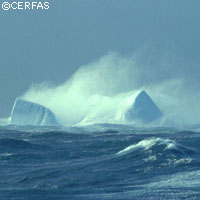Southern Ocean depths a 'treasure trove' of life
The dark depths of the Southern Ocean are teeming with life, according to new research which challenges the idea that deep sea biodiversity around the Antarctic is relatively low. The work, which brought together researchers from 14 organisations in six European countries as well as the US, is published in the latest edition of the journal Nature. From 2002 to 2005, this international team studied the seafloor landscape and the creatures living at depths from 774 to 6,348 metres. While the species living in shallower Antarctic waters are relatively well studied, little is known about the species living at these great depths. Working from the German research ship Polarstern, the scientists brought up thousands of specimens from the depths, including carnivorous sponges, free-swimming worms, crustaceans and molluscs. A high proportion of the species were unknown to science. For example, of the 674 species of isopod (a type of crustacean) found, 86% were new to science, and of the 76 species of sponge discovered, 17 are new to science and 37 had never been found in the Southern Ocean before. 'What was once thought to be a featureless abyss is in fact a dynamic, variable and biologically rich environment,' said Dr Katrin Linse of the British Antarctic Survey. 'Finding this extraordinary treasure trove of marine life is our first step to understanding the complex relationships between the deep ocean and distribution of marine life.' The scientists were also keen to find out whether these deep sea species were more closely related to species from the nearby continental shelf, or deep water species from other oceans. The answer was both. Species living in the deepest part of the ocean tended to be related to species in other oceans, particularly the Atlantic. This was particularly true for groups which are good dispersers. In contrast, species such as nematode worms and seed shrimps, which are poor dispersers, tend to be more closely related to similar species found on the Antarctic continental shelf. According to the researchers, these species were likely pushed into the deeper water as the ice advanced and retreated with the glacial-interglacial cycles. 'The Antarctic deep sea is potentially the cradle of life of the global marine species,' said lead researcher Professor Angelika Brandt of the University of Hamburg. 'We now have a better understanding in the evolution of the marine species and how they can adapt to changes in climate and environments.' 'Our findings challenge suggestions that deep-sea diversity is depressed in the Southern Ocean and provide a basis for exploring the evolutionary significance of the varied biogeographic patterns observed in this remote environment,' the researchers conclude.
Countries
Antarctica



